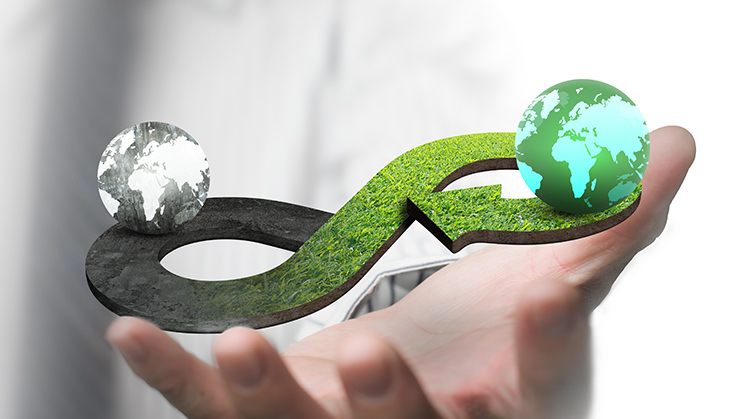What is the circular economy?
The circular economy, a new model for sustainable production and consumption
The circular economy entails a radical change in perspective by people and companies when it comes to dealing with the lack of resources, environmental impact, value creation and employment

The generation of waste as a result of economic activity and consumption generated in homes is one of the biggest problems facing the planet. According to a report by the World Bank External link, opens in new window. on the global solid waste management landscape, the world is expected to generate 3.4 billion tonnes of waste per year by 2050, a 70 % increase over 2016 levels. The results of the same document suggest a 19 % growth in daily per capita waste generation in high-income countries up to 2050, while in low- and middle-income countries this increase will be almost 40 % or more.
What is circular economy
The circular economy takes production processes into consideration and outlines how to reuse, repair, and recycle items, thus increasing sustainable manufacturing and consumption. This way, in addition to reducing waste, saves energy and helps avoid irreversible damage caused in terms of climate and biodiversity, as well as in terms of air, soil, and water pollution, owing to the use of resources at a rate that exceeds the Earth's capacity to renew them.
In order to mitigate the possible environmental consequences, it is necessary to minimise the generation of waste and encourage the use of products, materials, and resources that will remain in the economy for as long as possible. These are the foundations of the so-called circular economy which seeks a new model of production and consumption of goods and services associated with sustainability.
Society as a whole can and must help the circular economy become a widespread reality. For example, the UN has established the Sustainable Development Goals to ensure sustainable consumption and production patterns (Goal 12). These 17 goals are ambitious and universal, set forth as a call to action, so the main environmental, social and economic challenges the planet is facing can be addressed. Putting into practice the expression 'nothing is lost, everything is transformed' is a good way of doing our part.
Phases or stages of the circular economy
Las fases de la
economía circular
1
2
3
4
5
6
1
ECODISEÑO
2
PRODUCCIÓN /
REELABORACIÓN
3
DISTRIBUCIÓN
4
CONSUMO
5
REPARACIÓN /
REUTILIZACIÓN
6
RECICLAJE
Descubre todas las fases haciendo clic en cada número
Advantages of the circular economy
Below, we review some of the main advantages of the application of the circular economy in society:
- Protects biodiversity: by reusing products, this model of production and consumption minimises the use of natural resources, thus avoiding human activity that generates changes in nature.
- Reduce emissions: Industrial processes and the production of new products, as well as waste management, are responsible for significant greenhouse gas emissions. In fact, the United Nations argues that changing the way we produce could reduce emissions from industries (steel, cement, aluminium and plastics in particular) by up to 40% by 2050, compared to 2021 levels.
- Create value at industry level: the circular economy also represents a good growth opportunity for some sectors along the supply chain. According to a report published by Thredup by 2023, for example, the second-hand clothing sector will double in size by 2027, reaching a turnover of $350 billion worldwide.
- Reduce dependence on raw materials: the linear economic model, based on produce, consume and dispose, is heavily dependent on raw materials for its functioning. Ending this leads to many benefits such as guaranteed supply, price stability and the maintenance of natural capital.
- It generates new jobs: the latest studies on this production model indicate that in the coming years there will be more demand for professionals capable of working in the circular economy sectors. According to the International Labour Organisation, 24 million new jobs could be created by 2030 if the necessary policies are put in place to promote the circular economy.

Circular design
How to rethink the creative process and commit to sustainability.

Bioeconomy
The challenges of a key model for sustainable development.

Eco-design
How to manufacture sustainable products to satisfy consumers.

A barter market
How to recycle and how to generate less waste.
Circular economy model at the Iberdrola Group
At Iberdrola, we work to be more respectful of nature in our three strategic sustainability areas: climate action, biodiversity protection, and circular economy.
For this reason, our sustainable business model is based on the circular economy model, a system for making the most of resources in which priority is given to reducing the use of new raw materials through efficiency in processes, product life extensions, and a firm commitment to the reuse and recycling of materials.




